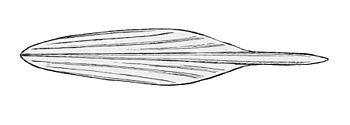
The gladius (pl.: gladii), or pen, is a hard internal bodypart found in many cephalopods of the superorder Decapodiformes (particularly squids) and in a single extant member of the Octopodiformes, the vampire squid (Vampyroteuthis infernalis). It is so named for its superficial resemblance to the Roman short sword of the same name, and is a vestige of the ancestral mollusc shell, which was external. The gladius is located dorsally within the mantle and usually extends for its entire length. Composed primarily of chitin, it lies within the shell sac, which is responsible for its secretion. Some species, like the bigfin reef squid, still has a gladius with some degree of mineralization.


Gladii are known from a number of extinct cephalopod groups, including teudopseids (e.g. Actinosepia, Glyphiteuthis, Muensterella, Palaeololigo, Teudopsinia, Teudopsis, and Trachyteuthis), loligosepiids (e.g. Geopeltis, Jeletzkyteuthis, and Loligosepia), and prototeuthids (e.g. Dorateuthis, Paraplesioteuthis, and Plesioteuthis).
Variability
Gladii are shaped in many distinctive ways and vary considerably between species, though are often like a feather or leaf. Some examples are shown below.

See also
References
- ^ Young, R.E.; Vecchione, M.; Mangold, K.M., eds. (1999). "Cephalopod gladius terminology". Tree of Life Web Project.
- Hunt, S.; Nixon, M. (1981). "A comparative study of protein composition in the chitin-protein complexes of the beak, pen, sucker disc, radula and oesophageal cuticle of cephalopods". Comparative Biochemistry and Physiology B. 68 (4): 535–546. doi:10.1016/0305-0491(81)90071-7.
- Messerli, Mark A.; Raihan, M. Jahir; Kobylkevich, Brian M.; Benson, Austin C.; Bruening, Kristi S.; Shribak, Michael; Rosenthal, Joshua J. C.; Sohn, Joel J. (2019). "Construction and Composition of the Squid Pen from Doryteuthis pealeii". The Biological Bulletin. 237 (1): 1–15. doi:10.1086/704209. PMC 7340512. PMID 31441702.
- Fuchs, D.; Engeser, T.; Keupp, H. (2007). "Gladius shape variation in coleoid cephalopod Trachyteuthis from the Upper Jurassic Nusplingen and Solnhofen Plattenkalks" (PDF). Acta Palaeontologica Polonica. 52 (3): 575–589.
- Fuchs, D., ed. (2010). "Teudopseina". Tree of Life Web Project.
Further reading
- Bizikov, V.A. (1991). Squid gladius: Its use for the study of growth, age, intraspecies structure and evolution (on the example of the family Ommastrephidae) (Ph.D.) (in Russian and English). Moscow: Institute of Oceanology, SSSR Academy of Sciences. 513 pp.
- Toll, R.B. (1982). The comparative morphology of the gladius in the order Teuthoidea (Mollusca: Cephalopoda) in relation to systematics and phylogeny (Ph.D.). Coral Gables, Florida: University of Miami. 390 pp.
- Toll, R.B. (1998). "The gladius in teuthoid systematics". Smithsonian Contributions to Zoology. 586 (1): 55–67.
| Cephalopod anatomy | ||||||||||||||
|---|---|---|---|---|---|---|---|---|---|---|---|---|---|---|
| Shell |
|    | ||||||||||||
| Mantle & funnel |
| |||||||||||||
| Head & limbs |
| |||||||||||||
| General |
| |||||||||||||
| Developmental stages: Spawn → Paralarva (Doratopsis stage) → Juvenile → Subadult → Adult • Egg fossils • Protoconch (embryonic shell) | ||||||||||||||















